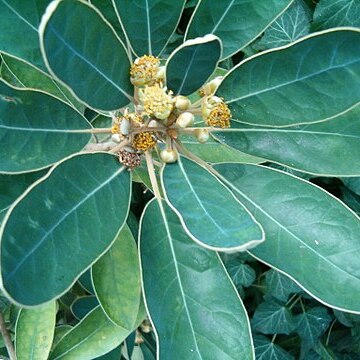Trees or shrubs, evergreen or deciduous, dioecious. Leaves alternate, rarely opposite or verticillate, pinninerved. Umbels, or umbellate cymes or panicles, solitary or clustered in leaf axils; involucral bracts 4-6, decussate, persistent at flowering. Perianth tube long or short, segments usually 6, in 2 whorls of 3 each, equal or unequal, rarely lacking or 8. Flowers unisexual. Male flowers: fertile stamens 9 or 12, rarely more, in 3 or 4 whorls of 3 each; filaments of 1st and 2nd whorls usually eglandular, of 3rd and 4th 2-glandular at base; anthers all introrse, 4-celled, cells opening by lids; rudimentary pistil present or lacking. Female flowers: staminodes as many as stamens of male flowers; ovary superior; style conspicuous. Fruit seated on perianth tube; perianth tube ± enlarged, shallowly discoid or deeply cup-shaped or unaltered at fruit.
Shrubs [or trees] , deciduous [or evergreen]. Leaves alternate, not aromatic. Leaf blade pinnately veined, rarely with 3 primary veins, leathery; surfaces glabrous or variously pubescent; domatia absent. Inflorescences appearing with or before new leaves, axillary, pseudoumbels, subtended by decussate bracts. Flowers unisexual, staminate and pistillate on different plants; tepals deciduous, yellow, green, or white, equal, glabrous. Staminate flowers: stamens 9 (or 12); anthers 4-locular, 4-valved, introrse. Pistillate flowers: staminodes 9 (or 12); ovary globose. Drupe red, globose, seated in small, single-rimmed cupule.
Fls in small umbels, enclosed before anthesis by 4-6 involucral scales; per. us. 4-6-lobed. ♂ with 9-12 stamens and abortive ovary; anthers 4-celled; inner row of filaments glandular at base. ♀ bearing staminodes; stigma us. dilated and irregularly lobed. Fr. drupaceous, seated in persistent, us. enlarged per. tube. About 180 spp., mostly tropical, of dioec. trees or shrubs with opp., rarely alt., lvs.


